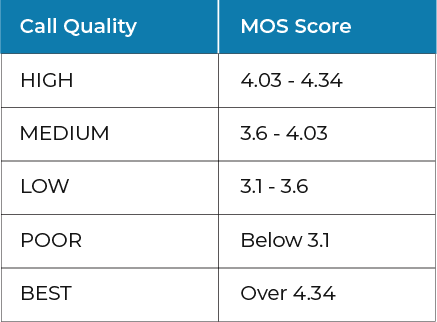Voice over IP (VoIP) is an internet-based technology that allows users to make and receive voice calls instead of using traditional telephone lines. VoIP has many benefits, such as lower costs, higher scalability, and more flexibility. However, VoIP also faces some challenges, such as network congestion, packet loss, latency, and jitter, which can affect the quality of voice calls.
From 2016 to 2024, the global VoIP market is expected to increase at a compound yearly growth rate of 20.4%, reaching USD 145.8 billion.
Summary:
MOS was originally designed for traditional phone communications, but in the ITU-T PESQ P.862, it was modified to phone over IP (VoIP).
MOS is a profitable metric for VoIP service providers and users, as it can-
- Monitor
- Troubleshoot
- Improve the quality of voice calls.
When it comes to evaluating the quality of voice calls, the Mean Opinion Score (MOS) is a frequently used and acknowledged metric. MOS is a subjective statistic that allows customers to score their voice call experience based on their perceived call quality.
Advantages of measuring the overall voice call quality using MOS:
Assist in identifying and diagnosing network issues that impair VoIP quality. By evaluating MOS for various network segments such as LAN, WAN, Internet, and Service Provider Networks, it is feasible to discover where and what causes quality degradation. For example, if MOS reduces significantly between the LAN and the WAN, it could signal a router or firewall configuration issue. If MOS dips between the Internet and the Service Provider Network, it could signal a problem with the service provider’s bandwidth or routing.
User-centric statistic that accounts for users’ subjective perceptions. It takes into account numerous aspects that can impair call quality, such as audio clarity, speech delay, echo, and background noise, from the end user’s perspective. MOS provides insights into the whole user experience, which is crucial in evaluating the effectiveness of a voice communication system, by incorporating the perspectives of users who are directly touched by call quality.
Delivers a real-world evaluation of voice call quality by collecting user experiences in actual call settings. MOS, as opposed to technical metrics that simply evaluate network performance, shows the end-to-end quality of a voice call, including network and device performance as well as the impact of environmental elements like background noise or the quality of the user’s audio equipment.
Can help compare and optimise different VoIP codecs and settings. VoIP codecs are algorithms that compress and decompress voice signals to reduce bandwidth consumption and improve transmission efficiency. However, different codecs have different trade-offs between quality and bandwidth. For example, G.711 is an uncompressed codec that offers high quality but uses more bandwidth than compressed codecs such as G.729. By measuring MOS for different codecs and settings, bit rate, etc., it is possible to find the optimal combination that maximises quality while minimising bandwidth.
Challenges of measuring MOS for VoIP calls:
- It requires specialised tools and expertise.
- It may not capture all aspects of voice quality, such as intelligibility, naturalness, or comfort.
Therefore, it is important to complement MOS with other metrics and methods, such as network performance indicators, user feedback surveys, or audio quality tests.
If you are looking for a reliable and easy-to-use tool to measure MOS for your VoIP calls, you should check out Route Mobile’s Voice and Video API. Route Mobile’s Voice API is a cloud-based platform that enables you to make and receive high-quality voice calls over the internet using any device or application. With excellent voice call quality along with other features such as video calling, conferencing, recording, transcription and more, Route Mobile’s Voice API supports over 800 networks in more than 200 countries and regions. Users can make and receive voice calls anywhere in the world with low latency and high reliability. One of the other ways to enhance voice quality is using video APIs that enable seamless video communication over the internet. Video APIs are software tools that allow developers to integrate video features into their applications without having to deal with complex technical details.
If you are looking for a reliable and high-quality VoIP service provider, Contact us our support team now!











